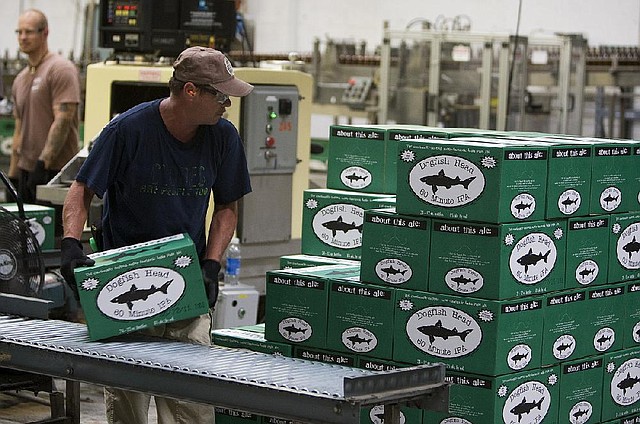Big names push craftlike beers
Brewers take sales from own ailing brands, analysts say
Employees work on the bottling line at Dogfish Head Craft Brewery Inc. facility in Milton, Del. Craft-beer sales grew 16 percent in volume over the past year, while sales of the biggest U.S. beer brands fell 1.7 percent, according to researcher Symphony IRI Group.
Sunday, January 26, 2014
Goose Island is the new Bud. So are Shock Top and ZiegenBock. And Leinenkugel’s and Blue Moon, for that matter, could be called the new Coors or Miller.
Those brands are all owned by the world’s biggest brewers, which are aggressively rolling out products designed to appeal to fans of craft beer. But they’re not putting the microbrewers who started the movement out of business.
Instead, the new labels are taking sales from already troubled mass-market brands owned by the industry giants peddling these newer brews. Analysts said that may actually be a boon for their owners as margins can be “considerably higher” for craft beers, according to researcher Canadean.
“I don’t really drink Bud Light anymore,” said Tait Foster, a 27-year-old who works at a foreign policy research group in New York. Instead, he’s started sampling a wider range of brews such as Goose Island and Blue Moon. “Bud Light, Coors and all those others are like beer-flavored water.”
Sales of craft beers grew 16 percent in volume over the past year versus a 1.7 percent decline for the biggest U.S. beer brands, according to researcher Symphony IRI Group. Sales of Bud Light were off by 1.3 percent, and Miller Lite slid 4.4 percent.
That’s prompted multinationals such as Anheuser-Busch InBev NV and Miller-Coors LLC, with about 75 percent of the U.S. market between them, to introduce their own craftlike brews - many of which make little or no mention of their corporate parentage.
AB InBev paid $38.8 million for Goose Island in 2011, five years after it signed a distribution deal with the Chicago brewer. And in 2006 it created Shock Top, a Belgian-style wheat ale, to take on Blue Moon, the biggest of the craftlike labels owned by industry leaders. The Goose Island brands soared 69 percent last year, AB InBev said, citing Symphony IRI data, while Shock Top beers jumped 14 percent.
MillerCoors, co-owned by SABMiller Plc and Molson Coors Brewing Co., in 2010 set up a unit called Tenth & Blake to focus on Blue Moon and other niche brews, as well as premium imports such as Pilsner Urquell from the Czech Republic and Cusquena from Peru. Today, it has more than a dozen brands, including two hard ciders.
“We looked at where the growth sectors were, and craft was exploding,” said Tom Cardella, president of Tenth & Blake. “When you look at the marketing of craft, it requires a different approach.”
As the popularity of these beers cuts into sales of the biggest brands, it’s fostering a new crop of mid-sized labels, said Trevor Stirling, an analyst at Sanford C. Bernstein. Craft brews are also wooing drinkers back from wine and spirits. While craft beer currently has only about 6 percent of the market, that share could more than triple in the next five years, Canadean predicted.
“There’s a new generation choosing a much broader repertoire of drinks,” Stirling said. “It’s virtually inevitable that the larger brands will lose market share to craft.”
That’s not to say that the big brands are going to give up on their mass-market brews anytime soon. With about 21 percent of the beer market by volume, Bud Light alone is about triple the size of the entire craft sector, Symphony IRI data show.
“I don’t see the era of big brands being over, but more that there’ll be a bigger mix of beers,” said Lawrence Hutter, who heads the European corporate solutions unit at consultant Alvarez & Marsal. “Don’t forget people still like those lighter, lager-style beers; they’re very drinkable.”
The U.S. Brewers Association defines “craft” as beers with annual sales below 6 million barrels and ownership by a big player of no more than 25 percent. Despite the industry’s homespun image, 60 percent of drinkers don’t give much thought to what company owns the brand of beer they drink, according to a survey by AB InBev.
“It’s kind of a disconnect for me that being bigger is necessarily bad,” said Paul Chibe, head of U.S. marketing at AB InBev. “What’s important is that if a beer gets bigger, it has to stay true to what it is.”
Even as the giant brewers lose share with their leading brands, the shift could shore up their profits since their craftlike beers enjoy higher margins, analysts and the companies said. Goose Island retails for an average of about $33.10 per case versus $20.17 for Bud Light, according to Symphony IRI. Some offshoots can be far pricier. Goose Island sells a brew called Bourbon County Stout one day a year, the Friday after Thanksgiving, for about $25 for a four-pack of 12-ounce bottles.
The higher prices help offset the added costs the industry’s giants face in producing more small brands. They are typically more labor-intensive, use a wider range of ingredients, and have more elaborate packaging and marketing.
The big companies also gain an edge over smaller rivals by producing the craftlike brands in their industrial-scale breweries. Blue Moon is brewed at MillerCoors’ facilities across the U.S. And some Goose Island beers are made by AB In-Bev in Fort Collins, Colo., and Baldwinsville, N.Y., in addition to the brand’s original brewery in Chicago.
“We’ve been a great home for craft brands like Goose Island,” helping out with additional production capacity as their popularity grows, Chibe said. “They have their own leadership team, their own innovation group; the brewers do their own things. We primarily behave as the rich uncle. When they need resources, we give it to them.”
Business, Pages 66 on 01/26/2014
